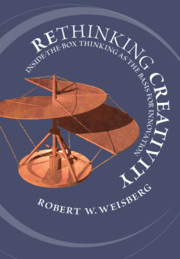Why Deep Inside the Box Thinking is a Prerequisite for Creativity
"A paradox of creativity"
One of the paradoxes of creativity is that creativity associated with the openness of ideas needs constraints to operate. See also my earlier post.
Orson Welles said: “The enemy of art is the absence of limitations.”
and
G. K. Chesterton once said, “Art consists in limitation. The most beautiful part of every picture is the frame.”
The tension between "thinking outside the box," as recommended by motivators, and "thinking inside the box" is a common topic. There are numerous examples available to support both perspectives.
A serious attempt to study thinking inside the box was made by Robert W. Weisberg who wrote the book, “Rethinking Creativity, Inside-the-Box Thinking as the Basis for Innovation” by Cambridge University Press, 2020.
In Chapter 8 of the book, “The Question of Unconscious Processes in Creative Thinking”, Poincaré's introspective observations of his scientific experiences are recounted and give a clue as to why the first stage (intense conscious work) of his creative process is so important and how combinations of ideas come about.
Figure the future elements of our combinations as something like the hooked atoms of Epicurus. During the complete repose of the mind, these atoms are motionless, they are, so to speak, hooked to the wall ... On the other hand, during a period of apparent rest and unconscious work, certain of them are detached from the wall and put in motion. ... Their mutual impacts may produce new combinations. — Poincaré, Science and Method
If we envision ideas as atoms or molecules, they are typically "anchored to the wall." However, with initial deep work on the problem, they are "set in motion" and initiate a combinatorial process. The preliminary deep work, which is done inside the box, provides the atoms with kinetic energy.
After the atoms are set in motion, the incubation period begins. During this stage, intense focus is no longer necessary, and the combinatorial process requires less attention and awareness. It is an automatic process that can operate in the background.
Unlike Poincaré, I believe that the incubation period is not necessarily nonconscious. It can occur while taking a walk, drinking coffee, meditating, or during periods of sleep or semi-consciousness.
Now coming back to the “box”, if you accept the above description of deep work to set atoms in motion, you will also understand why constraints (i.e. the box) are absolutely necessary for the first stage. Without constraints, there will be too many ideas, and their combinations would be chaotic.
The question remains, how the constraints are to be determined? Obviously, not all constraints are conducive to creativity. The types and the number of constraints are crucial. But I believe I have answered that when discussing compelling diagrams and Prägnanz


